(Photo by Shelley Lipton/Icon Sportswire)
In the top of the first inning last night, Pittsburgh Pirates starter Jameson Taillon threw a three-pitch strikeout to Kansas City Royals hitter Jorge Bonifacio. While on the surface, it looks as though Taillon simply beat him by changing locations and eye level. While that is true to some extent, there is more going on that contributed to Taillon beating Bonifacio– Perry Husband’s Effective Velocity.
Though Taillon attacked Bonifacio in a productive manner, he almost made a crucial mistake that could have cost Pittsburgh the game. I’ll get to what he could have done to have made it less likely using Ev principals. In my last article pertaining to Ev, I used this same chart below (scaled to righties). You’ll want to keep this in mind throughout this breakdown.
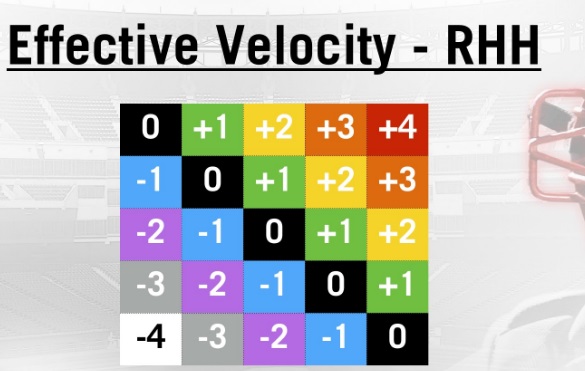
Image 1
First, let’s look at the three-pitch sequence.
[gfycat data_id=”VigilantBrokenGlassfrog”]
Before I get into the breakdown of each pitch, let’s understand that Bonifacio (like other Major League Baseball hitters) is aware of Taillon’s repertoire, his tendencies, and more importantly his velocity. Knowing a pitchers velocity is vital because, above all else, timing is very important to making good contact and a key component of Ev.
Taillon uses two pitches during this at-bat; his four-seam fastball and slider. On average, Taillon’s four-seam fastball sits around 95 MPH and his slider is around 90 MPH. The hitter’s ‘mind’s eye’ (as Mr. Husband would put it) is going set his body timing to that velocity. This is the first (and perhaps biggest) mistake that is being made by hitters. You can read a radar gun and compile average velocities so you know what to expect, but hitters are not accounting for the location of those pitches, and the impact Ev has on them. The following will explain why that is very important.
Taillon starts with a down and away slider for a strike; radar gun reads 90 MPH, which is right in line with what Bonifacio sees and expects. Except he’s wrong. His body and his mind are already out of sync. How? Looking at Image 2, the pitch is actually closer to 86 MPH (-4 Ev zone). This pitch ends up in what Mr. Husband calls the ‘pressure zone’; a spot just outside the strike zone where the hitter feels the ‘pressure’ to swing. We can see it lands a tad outside but it was close enough to the umpire to deem it a strike.
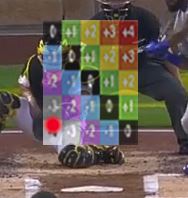
Image 2
To put this into further context, you have to understand that 86MPH is the speed at which the hitter needs to react to a 90 MPH pitch located in that portion of the Ev zone. Meaning, despite the fact that the radar gun reads 90 MPH, to make good contact, Bonifacio has to time the pitch as if it were coming to the heart of the strike zone at 86 MPH. And when I say ‘time’ the pitch, I mean his body and swing mechanics have to be in line with that velocity in order to make the type of contact Bonifacio ultimately desires.
Image 3 shows pitch number two; a 95 MPH four-seam fastball that Bonifacio again takes for a strike.
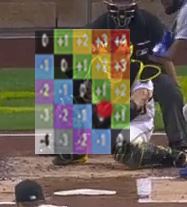
Image 3
We can see that this pitch hits right around the null Ev zone, meaning that the velocity we see is the actual reaction speed Bonifacio has to adjust around to be right on time for solid contact. Taillon has now (consciously or unconsciously) used Ev to create a nice velocity spread. The ‘actual’ speed of the first two pitches are 5 MPH apart (90 MPH, 95 MPH) but Bonifacio’s ‘mind’s eye’ would be required to interpret these two pitches as being 9 MPH apart (86 MPH, 95 MPH), which is an ideal differential for a pitcher.
Mr. Husband points out in his research that strong/barreled contact occurs roughly 50% of the time when velocity is ‘effectively’ 6 or less MPH apart in sequential pitches.
Another pitching aspect (philosophy?) that Ev relies on is pitch tunneling. And Taillon executes it perfectly with these first two pitches (red is the slider, yellow is the four-seam). Have a look.
[gfycat data_id=”AshamedMistyBee”]
After Bonifacio saw the slider, the next pitch (the four-seam) traveled along that same tunnel perhaps fooling him into thinking he was going to get another slider or breaking pitch. If you go back to the sequence video, you see Bonifacio flinch a little because once the pitch one and two hit near the commit point, they break off and do their own thing. Bonifacio has to hold up because he wasn’t expecting a fastball nor was he prepared for the velocity of the pitch.
Furthermore, Taillon’s release points (to include pitch three) are nearly identical; more so on pitches one and two.
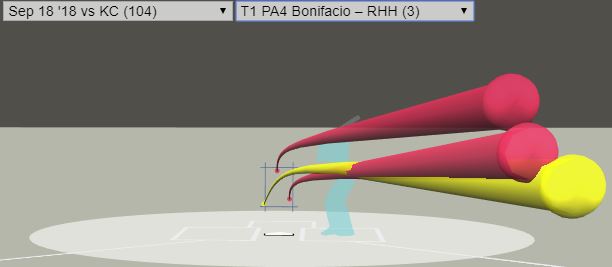
Image 4
That alone gave Taillon a HUGE advantage over the hitter. Being able to change speeds effectively, using a tunnel, and keeping release points as close as possible already hinder the batter. Being able to capitalize on Ev makes an at-bat downright unfair.
Now we have pitch number three; another 95 MPH four-seam fastball. This time Taillon goes high in the zone and creates an Ev of about 96 MPH. In that location, it could be considered 97 MPH but I’ll explain in a minute why it’s not too relevant at this point, but will be in a moment.
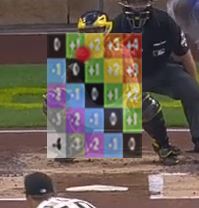
Image 5
I did not include pitch three in the overlay gif because, despite the similar release points, the second four-seam fastball traveled above the previous tunnel (and that was used as part of Taillon’s deception during this at-bat). However, going back to Ev spread principals, the less than 6 MPH Ev difference (95 MPH, 96 MPH) can a dangerous combination the closer you get to zero. Regardless, Taillon is able to use location changes to his advantage; Bonifacio got two different pitches down in the zone previously.
Looking closer at pitch number three, we can see that Bonifacio is late. How can we tell without a side view? Image 6 shows that the bat moves in a manner that, should he make contact, will happen closer to the handle (note the red ‘x’) than the barrel (yellow dot); he’s not ideally extended and is cheating in a tad.
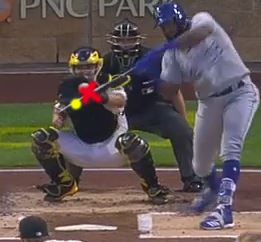
Image 6
Bonifacio is fooled by the velocity and the fact that he likely wasn’t expecting another fastball. Image 7 backs that assertion because, when facing righties with two strikes, Taillon’s tendency is to use his curveball over a third of the time.
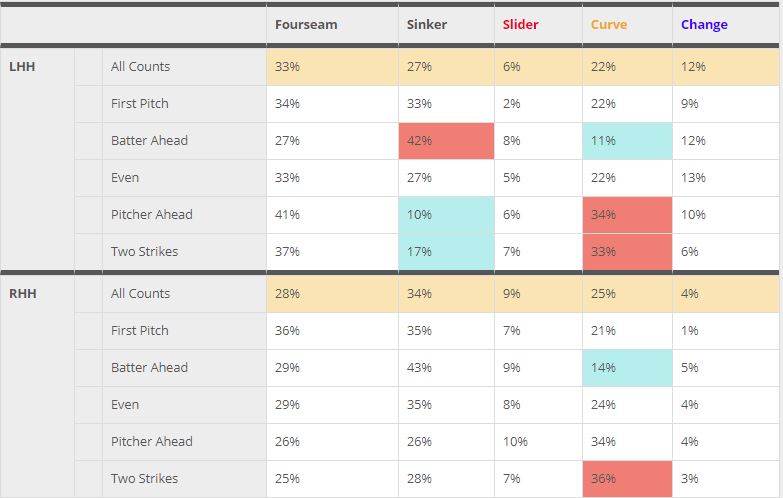
Image 7
Now the problem I find here is when looking back up at Image 6, Bonifacio was late, but not that late. He did Taillon a favor and I say this because if he was on time, he may very well have crushed that pitch over 400 feet and potentially gave the Pirates a loss last night. Regardless of the location of pitch two and three, Taillon didn’t spread his velocity far enough. Since he decided to go with another four-seam fastball, he would have done better to place the pitch elsewhere; maybe further in on Bonifacio. If he placed the ball somewhere near the +3 or +4 zone, he could have been a little safer. Ideally, Taillon should have gone with something off-speed; his curve or even another slider, anywhere in the Ev zone that would have spread the velocity beyond the +6 MPH threshold. Again, it all worked out for Taillon but if he were more aware (if he already isn’t) of Ev, he could have been even more effective.
There are so many more aspects of this at-bat that could be discussed but I want to keep this concept as basic as possible for now; this is simply an abstraction of the ideals of Effective Velocity that I believe will one day change offense as we currently know it.
